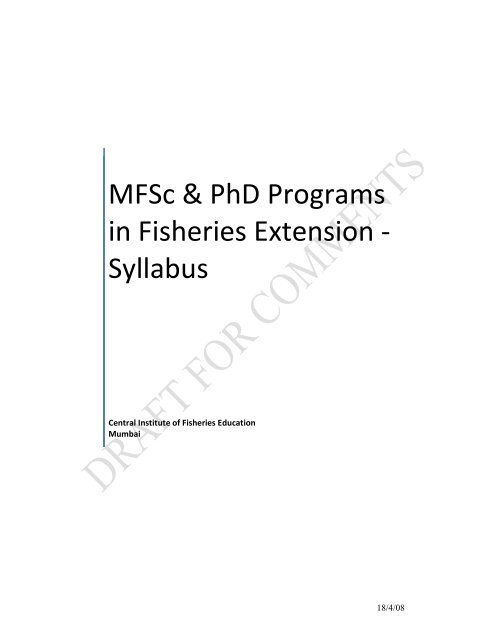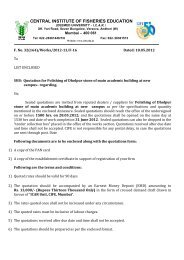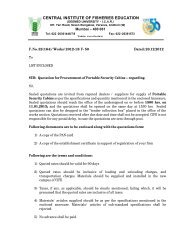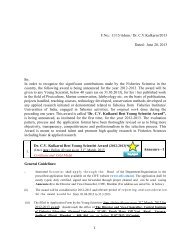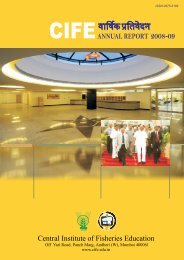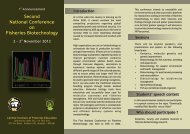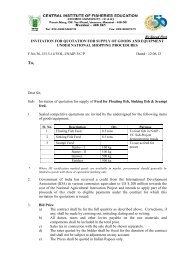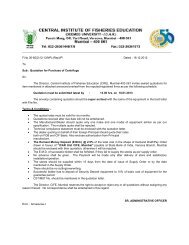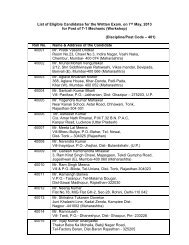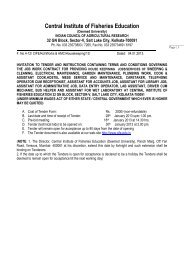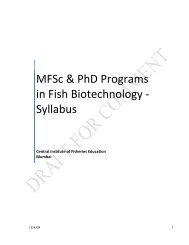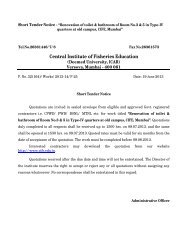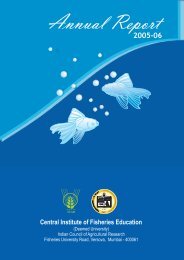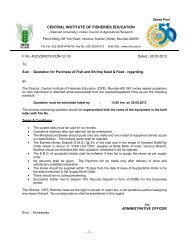Fisheries Extension Syllabus MFSc & PhD - Central Institute of ...
Fisheries Extension Syllabus MFSc & PhD - Central Institute of ...
Fisheries Extension Syllabus MFSc & PhD - Central Institute of ...
- No tags were found...
You also want an ePaper? Increase the reach of your titles
YUMPU automatically turns print PDFs into web optimized ePapers that Google loves.
<strong>MFSc</strong> & <strong>PhD</strong> Programsin <strong>Fisheries</strong> <strong>Extension</strong> -<strong>Syllabus</strong><strong>Central</strong> <strong>Institute</strong> <strong>of</strong> <strong>Fisheries</strong> EducationMumbai18/4/08
M.F.Sc. (<strong>Fisheries</strong> <strong>Extension</strong>) Program Structure and Major CoursesCode Course Title CreditsCORE COURSES1. FEX 501 Perspectives and Practices <strong>of</strong> <strong>Fisheries</strong> <strong>Extension</strong> 2+12. FEX 502 <strong>Extension</strong> Communication and Methods 2+13. FEX 503 Participatory Approaches in <strong>Fisheries</strong> <strong>Extension</strong>2+14. FEX 504 Training for Human Resource Development 2+1OPTIONAL COURSES1.Community Mobilisation and OrganisationalFEX 505Development1+12. FEX 506 Diffusion and Adoption <strong>of</strong> Innovations in <strong>Fisheries</strong> 1+13. FEX 507 Multimedia Creations and Applications 0+24. FEX 508 Planning and Management <strong>of</strong> Development Programs 1+15. FEX 509 Human Resource Management 1+16. FEX 510 Gender, Livelihood and Development 1+17. FEX 511 Development Journalism 1+18. FEX 512 Indigenous Technical Knowledge in <strong>Fisheries</strong> 1+19. FEX 513 Community Based Disaster Management 1+1Ph.D. Program in <strong>Fisheries</strong> <strong>Extension</strong> – Major CoursesCode Course Title CreditsCore Courses1. FEX 601 Advances in <strong>Fisheries</strong> <strong>Extension</strong> Management 2+12. FEX 602 Monitoring and Evaluation <strong>of</strong> Development Programs 2+13. FEX 603 Measurement and Scaling Techniques 2+1Optional Courses1. FEX 604 <strong>Extension</strong> Service System Management 1+12.Advances in Training Methods and EducationFEX 6051+1Technology3. FEX 606 Social and Gender Issues in <strong>Fisheries</strong> 1+14.Information and Communication Technology forFEX 6071+1<strong>Fisheries</strong> Development5. FEX 608 International Experiences in <strong>Fisheries</strong> <strong>Extension</strong> 1+16. FEX 609 Media and Communications Research 1+17. FEX 610 Ergonomics 1+118/4/08 2
<strong>MFSc</strong> <strong>Syllabus</strong>CORE COURSESFEX 501 Perspectives and Practices <strong>of</strong> <strong>Fisheries</strong> <strong>Extension</strong> 2+1Objectives:Theory• To gain analytical insights about different concepts, principles, praxis, recent changesand emerging challenges in fisheries extension• To acquire skills required to practice various fisheries extension approaches.Unit I: Overview <strong>of</strong> fisheries and aquaculture sector in India and world; Special characteristics <strong>of</strong>fisheries sector and its stakeholders; Understanding extension education, research, and service;Overview <strong>of</strong> fisheries research, development and extension systems in India; Scope andimportance <strong>of</strong> fisheries and aquaculture extension;Unit II: Critical review <strong>of</strong> philosophy, principles, concepts, and practices <strong>of</strong> fisheries extensionsystems and approaches; Teaching, learning and co-learning; Epistemology <strong>of</strong> knowledge infisheries – ITK vis-à-vis lab generated knowledge;Unit III: <strong>Fisheries</strong> extension – advantages and limitations <strong>of</strong> present welfare and subsidy orientedextension systems; Development and extension approaches as practiced by public agencies likeDepartment <strong>of</strong> <strong>Fisheries</strong>, KVKs, Agricultural Technology Management Agency (ATMA), NGOs,FAO, Bay <strong>of</strong> Bengal Programme (BOBP-IGO), and by the private sector; participatory fisheriesextension approaches;Unit IV: Aquaculture extension system - review <strong>of</strong> extension approach as practiced by DoF, FFDA,and BFDA; Market led extension approaches; Importance <strong>of</strong> Information and CommunicationTechnology (ICT) in fisheries extension system.PracticalExercises on development <strong>of</strong> extension and field manuals; Exercises on participatory learning /co-learning; Case study <strong>of</strong> extension approaches practiced by select State Departments <strong>of</strong><strong>Fisheries</strong>, FFDAs / BFDAs, select NGOs, AMUL model; case study <strong>of</strong> market led extensionapproaches like e-choupal choupal, Agri Business Clinics, etc.; Critical review <strong>of</strong> experiences andlessons from fisheries extension practices from across the world; case study on the use <strong>of</strong> ICT forfisheries development; Field exposure by visiting established extension projects;Suggested Readings1. C. Ramchandran, 2004, Teaching not To F(in)ish: A constructivist Perspective on Reinventing aResponsible Marine <strong>Fisheries</strong> <strong>Extension</strong> System, CMFRI, Kochi2. Dilip Kumar, 1996, Aquaculture <strong>Extension</strong> Services Review: India, FAO <strong>Fisheries</strong> Circular No. 906,FAO, Rome3. Ray, G. L.(2006). <strong>Extension</strong>, Communication and Management. Sixth edition, Kalyani Publication(PD)4. Rivera, W.M., Agricultural <strong>Extension</strong>: Worldwide Institutional Evolution and Forces for Change,Elsevier Science Ltd .5. Malhotra, S.P. and Sinha, V.R.P. 2007. Indian <strong>Fisheries</strong> and Aquaculture in a Globalizing EconomyPart II, Narendra Publishing House (RS)6. Chandrasekhar (Ed.), Privatization <strong>of</strong> Agricultural <strong>Extension</strong> in India. MANAGE, Hyderabad.18/4/08 3
FEX 502 <strong>Extension</strong> Communication and Methods 2+1ObjectivesTheory• To learn about different communication strategies used in mass, group and personalcontact methods <strong>of</strong> extension programme• To get hands on training in application <strong>of</strong> extension methods and communication aidsUnit I: Communication - meaning, process, theories and models; Traditional communication;Individual, group and mass communication, levels <strong>of</strong> communication; non-verbalcommunication; AV aids – selection and use;Unit II: communicator - role <strong>of</strong> communicator in extension education, communicator’sbehaviour; communication skills; fidelity <strong>of</strong> communication; communication competence andempathy; communication effectiveness and credibility; improving oral and writtencommunication; message – meaning, dimensions, characteristics, treatment and effectiveness,distortion <strong>of</strong> message; simulation exercises; channels <strong>of</strong> communication – meaning, dimensions,classification, selection, efficiency, credibility, use; audience or receivers; feedback;communication behaviour; social network – homophily and heterophily;Unit III: communicating with fishers and fish farmers; barriers in communication; communicationand social change; futuristic shape <strong>of</strong> communication technologies.Unit IV: Recent communication technologies – Internet based technologies, video andteleconferencing, computer assisted instructions, Information kiosks, Village Resource Centres,Community networks, WAN, MAN, AGRINEt, e-Governance; Cyber extension and e-learning.PracticalExercises in written and oral communication; documenting and presenting success stories infisheries, AV aids - rationale and preparation <strong>of</strong> AV aids with local resources; public speakingand presentation skills; organising meetings, guided discussions; organizing field demonstrationsand field-days; preparation <strong>of</strong> information, education and communication materials on variousaspects <strong>of</strong> fisheries; instructional video and ICT; Practicing tele and video conferencing, casestudy <strong>of</strong> a community radio, tele-centres and farmer discussion groups; designing a website onfisheries and aquaculture; developing a script and shooting a video film as an extension aid;Development and use <strong>of</strong> e-learning modules.Suggested Readings1. Van Den Ban, A.W., Communication for Rural Innovation: Rethinking Agricultural <strong>Extension</strong>,Blackwell Pub.2. Francis Xavier Moakley, Handbook <strong>of</strong> audio-visual aids, Publisher: Harcourt Brace Jovanovich(1973)3. R K Samanta (1990) Development Communication for Agriculture. D.K. publishers. New Delhi4. K B Mathur (1994) Communication for Development and Social change. Allied Publishers Limited,New Delhi5. Lesiskar, R.V. and Pettit, J.D., Business Communication, 8 th Edition Tata Mc Graw- Hill6. Locker, K.O. & Kaczmark, Business Communication-Building Critical Skills, Tata McGraw Hill. RanjitSingh (1993) Communication Technology for rural development B.R. publishing corpn. Delhi18/4/08 4
FEX 503 Participatory Approaches in <strong>Fisheries</strong> <strong>Extension</strong> 2+1ObjectivesTheory• to gain conceptual understanding about participatory approaches to fisheries extensionprogrammes• to gain practical experience in participatory approaches and techniquesUnit I: Participatory approaches for aquatic resources management and development: need,importance and guiding principles; Community mobilization methods - Farmer-First Approach;Trickle Down System – concept, method and processes; Knowledge Driven <strong>Extension</strong> System –concept and method;Unit II: Community based fisheries management and <strong>Fisheries</strong> co-management – concept, origin,importance, types, method, processes, stakeholder rights, responsibilities and participation,institutional mechanisms, implementation constraints, experiences from other countries;conflict resolution and management; Public-Private-Community Partnership;Unit III: Participatory Learning Approach (PLA) including role-plays, case studies, brainstorming,and ranking <strong>of</strong> priority issues, discovery-based experiential learning, participatory educationmethods like FGD; Participatory appraisal techniques - census mapping, resource mapping,social mapping; selection <strong>of</strong> participatory methods and their uses; Farmer Field Schools forAquaculture.PracticalConducting Participatory Rural Appraisal in select villages and developing action plans;Conducting Focused Group Discussion and developing action plan; Facilitating group formationbased on the felt needs and to implement the action plans / plan <strong>of</strong> work; Reviewing nationaland international case studies on participatory approach to aquaculture research anddevelopment; case studies and simulation exercises on fisheries co-management / communitybased fisheries management.Suggested Readings1. David Brown, Derek Staples and Simon Funge-Smith, Mainstreaming fisheries co- Management inthe Asia-Pacific, Asia-Pacific Fishery CommissionRap Publication 2005/24, Food And Agriculture Organization <strong>of</strong> The United Nations RegionalOffice For Asia And The Pacific, Bangkok, 20052. Robert S. Pomeroy, <strong>Fisheries</strong> Co-Management: A Practical Hand book, CABI3. Edwards P. Little D.C. and Demaine, H. 2002. Rural Aquaculture, CABI Publishing (RS)4. Dilip Kumar, 1999. Trickle Down System (TDS) <strong>of</strong> Aquaculture <strong>Extension</strong> for Rural Development,RAP Publication (RS)5. R.Chambers ;P.Arnold and Thrupp (1989) Farmers First : Farmer innovation and AgriculturalResearch. Intermediate Technology6. Chambers R. (1983) Rural Development Putting the last first. Longman18/4/08 5
FEX 504 Training for Human Resource Development 2+1ObjectivesTheory• To learn the design and methods <strong>of</strong> conducting training programmes for the trainers,fishers and fish farmers• To acquire hands-on practice in use <strong>of</strong> training aids and toolsUnit I: Human Resource Development – Concept and Significance; Education, Learning andTraining; Instructional Design and Educational Technology; Theories <strong>of</strong> Learning - RadicalBehaviorism, Cognitivism, Constructivism; Training and Development; Gender sensitive training;Unit II: Types <strong>of</strong> Training - Induction, On-the-job, Off-the-job, In-service, Customized, Inception,Trainers’, Participatory, Web-based, Fishers/fish farmers’, Farmer-led, vocational and echotraining;Training tools like T-Group, Fish bowl exercise, ice-breakers, team-building exercisesand games; workshop and writeshop;Unit III: Preparation <strong>of</strong> Training Manuals, content writing; Training cycle - training needassessment, developing training objectives and outcome, developing training modules andlesson plan, logistic management and evaluation <strong>of</strong> training programme, follow-up and actionplan;Unit IV: Facilitating Community Mobilization Process - Perception <strong>of</strong> service delivery system,level <strong>of</strong> expertise and capacity amongst the community to facilitate such services, willingness <strong>of</strong>the community to match individual interests with community interest, facilitation <strong>of</strong> resourcesfor mobilizing community; Promoting Public-Private-Community Participation.PracticalTraining need assessment for different clientele groups; Designing training tools and manuals onfisheries; Organising and conducting fisheries training programmes; Evaluation <strong>of</strong> training;Impact studies in terms <strong>of</strong> results (output, outcome and impact); Team building exercises.Suggested Readings1. R.P. Singh, A. Jhamtani and Premlata Singh (1996), Training Management . Jain Publishers, NewDelhi2. Lynton R.P and Pareek U (1973) Training for Development. Sage publications3. Misra D C (1990) New Directors in <strong>Extension</strong> Training. Directorate <strong>of</strong> <strong>Extension</strong>, Ministry <strong>of</strong>Agriculture, New Delhi4. Donald L. Kirkpatrick, Evaluating Training Programs: The Four Levels, Published Berrett-KoehlerPublishers 1998, ISBN 15767504265. Jack J. Phillips, Handbook <strong>of</strong> Training Evaluation and Measurement Methods, ISBN 10: 0-88415-387-86. Kumar, D. Ojha, S. N., Biradar, R.S. 2006. Public-Private and Community Participation forSustainable Rural Livelihood development through <strong>Fisheries</strong>. In: National Convention onKnowledge Driven Agricultural Development: Management <strong>of</strong> Change, Agricultural ResearchService Scientists’ Forum, New Delhi, 24-26 March 200618/4/08 6
FEX 505 Community Mobilisation and Organisation Development 1+1ObjectivesTheory• To gain insights into the relevant know-how about the structure and functions <strong>of</strong>community institutions• To acquire competency and confidence to bring about desirable social change byorganizing communitiesUnit I: Sociological and psychological perspectives <strong>of</strong> social institutions, culture, community andcommunity organization; functions <strong>of</strong> community; rural sociology and its relevance to extensioneducation; social stratification; social changes, conflict in rural society;Unit II: Communities as vehicles <strong>of</strong> change; community mobilization - entering, submerging,empowering and governance; outreach, community centres and services; models <strong>of</strong> communityorganization in developing countries; social action; challenges in mobilization, advocacy,coalition building and networking, facilitation and mediation; role <strong>of</strong> NGOs;Unit III: Rural development – rural context and livelihood, rural poverty, policies, programs andinterventions; rural local self governance – Panchayati Raj; rural-urban migration, socialproblems, displacement and rehabilitation; rights <strong>of</strong> indigenous communities; communityparticipation for natural resources management; strategies <strong>of</strong> developmental intervention;international processes and implications for local communities; leader and leadership – types,role, theories and its implication for development; motivation – theories, types and importance;social perceptions, influence and relationships; attitudes; emotion and stress;PracticalApproach to and strategies <strong>of</strong> community organizing – study <strong>of</strong> specific cases/illustrations <strong>of</strong>strategies and efforts on a range <strong>of</strong> issues that have been effective; exercises on communityorganisation; identification <strong>of</strong> village leaders and their role in community development; cases onsocial, cultural and technological changes; Preparing investigative report <strong>of</strong> fishing/fish farmingvillage considering culture, language, values, norms, institutions, social organization, groups,social stratification, social conflict, etc.Suggested Readings1. Harlambos, Sociology: Themes and Perspectives,2. Morgan et al, Psychology, Tata Mc Graw Hill Publishers3. JB Chitambar, 1990, Introductory Rural Sociology- Wiles Eastern Ltd, New Delhi4. Sinha, V.R.P. 1999. Rural Aquaculture in India, FAO <strong>of</strong> United Nations, Thailand, RAP publication(RS)Journals1. Journal <strong>of</strong> Social Work2. Indian Journal <strong>of</strong> Social Science Research3. Journal <strong>of</strong> Rural Development4. Indian Journal <strong>of</strong> Agricultural <strong>Extension</strong>5. Rural Sociology18/4/08 7
FEX 507 Multimedia Creations and Applications 0+2Objectives• To acquire competence and hands-on skills on preparation and application <strong>of</strong> variousmultimedia tools.PracticalMultimedia Environment - Multimedia Hardware Devices, Multimedia S<strong>of</strong>tware Tools,Multimedia Content Creation & Integration Process; Graphics and Effects – scanner, other imagecapture methods; Image editing and 2D Animation using Photoshop; Vector graphics using CorelDraw; Digital Audio - Basic features and digitization, audio recording and dubbing, audio card,non-linear editing and mixing <strong>of</strong> different audio formats, audio editing and composing <strong>of</strong> music,special effects; Script development and Story board preparation; Digital Video - analog anddigital video, video recording, capturing and conversion into different video file formats, videoediting, special effects;Organization <strong>of</strong> content - choice <strong>of</strong> media, categorization <strong>of</strong> photographs, queuing <strong>of</strong> audio andvideo clips, logical sequencing, text entry; Multimedia Authoring - concepts, navigation planningand hyper linking; User friendly tools - MS Office Power point, Macromedia Director;Preparation <strong>of</strong> multimedia presentation; CD/DVD writing, labeling and presentation.Suggested Readings1. http://www.good-tutorials.com/2. http://www.myphotoshoptuts.com3. http://www.sony101.com/4. http://www.w3schools.com/5. http://audacity.sourceforge.net/help/tutorials\6. http://www.mediacollege.com/video/editing/7. http://www.animationsforvideo.comFEX 508 Planning and Management <strong>of</strong> <strong>Fisheries</strong> Development Programs 1+1ObjectivesTheory• To understand different aspects <strong>of</strong> planning processes• To acquire competency to plan, implement, monitor and evaluate extension anddevelopment programsUnit I: Importance, Principles and Processes in Developing <strong>Extension</strong> Programmes; Planning forSustainable Development, Economic Planning- types <strong>of</strong> planning; Planning strategies at variouslevels- Top down and bottom up approaches. Panchayati Raj institutions; Execution <strong>of</strong> variousProgrammes, Plan allocation and performance <strong>of</strong> fisheries over the different plan-periods inIndia;Unit II: Project preparation and Project Appraisal in terms <strong>of</strong> social benefit analysis, shadowprices; Project Management Techniques - PERT and CPM; Logical Framework Approach (LFA),Stakeholder analysis; Participatory Monitoring and Evaluation (PROME); People’s participation in<strong>Extension</strong> Programmes, Significance, importance and approaches;18/4/08 9
Unit III: Critical analysis <strong>of</strong> Agriculture, <strong>Fisheries</strong> and Rural Development Programs; design,operation, institutional mechanism and socio-cultural and economic impact <strong>of</strong> programs such asNREGA; labour market relations; <strong>Fisheries</strong> development vis-à-vis fisheries for development;Livelihood Frameworks.PracticalNeed assessment, setting objectives, developing plan <strong>of</strong> work, Success indicators, Impactassessment <strong>of</strong> fisheries development programmes, SWOT analysis; Exercises on PERT and CPMPresentation <strong>of</strong> <strong>Fisheries</strong> and Aquaculture policies <strong>of</strong> select countries; Study visits to selectedextension project areas – DOE, KVKs, SAUs, and ICAR institutes.Suggested Readings1. M. L. Jhingan, Economics <strong>of</strong> Development and Planning2. Bilal U. Haq, 1997, Coastal Zone Management Imperative for Maritime Developing Nations, Springer, ISBN079234765XJournals1. Indian Journal <strong>of</strong> Agricultural <strong>Extension</strong>2. Journal <strong>of</strong> Rural Development3. Economic and Political Weekly4. Agricultural Economic Research ReviewBroad Areas <strong>of</strong> Research1. Reach and impact <strong>of</strong> fisheries innovationsFEX 509 Gender, Livelihood and Development 1+1ObjectivesTheory• To gain conceptual understanding on issues related to the gender, livelihood anddevelopment• To understand the trade <strong>of</strong>f between gender, livelihood and developmentUnit I: Theoretical foundations <strong>of</strong> gender: Social construction <strong>of</strong> gender, patriarchy, family andhousehold; Gender and Livelihood - Concept <strong>of</strong> livelihood, work, access and control <strong>of</strong> naturalresources, Livelihoods in transition; Gender and Development - women in development (WID),women and development (WAD) gender in development (GID), gender and development (GAD),Unit II: Indicators <strong>of</strong> status- Physical Quality <strong>of</strong> Life Indices (PQLI), Human Development Index(HDI); Rural-urban migration; Impact <strong>of</strong> fisheries development on men and women,Development strategies, Integrated model <strong>of</strong> development, micr<strong>of</strong>inance, SHGs, vocationaltraining and development , equality, constitutional protection; Planning and development forchange.Practical18/4/08 10
Developing case studies on social and gender issues in fisheries; Case studies on Rural –urbanmigration; Assessment <strong>of</strong> the social indicators –PQLI and HDI; Evaluation <strong>of</strong> the performance <strong>of</strong>the SHGs; Exercises on social and gender sensitive policies; Case studies on gender relations infisheries / rural development programs such as NREGASuggested Readings1. Agarwal Bina (1994) A field <strong>of</strong> one’s own: Gender and Land rights in South Asia, Canbridge: CambridgeUniversity Press.2. Menon Nivedita (1999) Gender and Politics in India, New Delhi: Oxford.3. Agarwal, B., Women, Poverty and Agricultural Growth in India, New Delhi, JPS, 1986.4. Bhasin, K., Understanding Gender, New Delhi, Kali for Women, 20005. Bhatt, Ela R. and others, Shramashakti: Report <strong>of</strong> National Commission on Self Employed Women and Govt.<strong>of</strong> India, 1988JournalsBroad Areas <strong>of</strong> ResearchFEX 510 Development Journalism 1+1ObjectivesTheory• To gain critical awareness and reflective ability necessary to identify, articulate andanalyse major issues in fisheries development• To gain knowledge on the different skills applicable in journalismUnit I: Media industry, concepts and theories in practice <strong>of</strong> news writing; relating theories <strong>of</strong>journalism to pr<strong>of</strong>essional practice; Development journalism – meaning, principles, importanceand scope; Basics <strong>of</strong> news production - gathering and selecting news, writing news fornewspapers, magazines, farm bulletins and folders, editorial writing, feature writing, headlineand cutline writing, news collection and interview, photography and art, copyediting andpro<strong>of</strong>reading, word processing, computer layout and designUnit II: Editing and design - introduction to news selection and emphasis; techniques and skillsfor editing print news media; critical analysis <strong>of</strong> layout and design conventions <strong>of</strong> print newsmedia;Unit III: Magazine journalism - pr<strong>of</strong>ile and feature writing; Radio and television journalism -principles and practices <strong>of</strong> gathering, writing and producing news for radio and television; Photojournalism - visual language, skills and techniques; New media journalism – websites and blogs,writing, editing and site design skills for online journalism; Responsible journalism - fairness andbalance, libel, and the commercial nature <strong>of</strong> the media, constructive criticism; advertisements –principles and practice; careers in journalismPracticalIdentification, articulation and analysis <strong>of</strong> major issues related to fisheries development; criticalanalysis <strong>of</strong> fisheries related news stories and feature articles from development magazines /news papers; Gathering and writing news stories, feature articles and editorials; Designing,editing and publishing campus news letters; interface with editors <strong>of</strong> journals and magazines;18/4/08 11
Critical analysis <strong>of</strong> fisheries related radio news stories; Producing radio news items for broadcast;digital photography and image editing; designing and developing a theme based website / blog;Visits to select printing presses, media organizations and news agencies.Suggested Readings1. Bond F.F. – An Introduction to Journalism, The Mac-million, Company, New York.2. Wainwright David – Journalism made simple, Rupa & Heinemani, London.3. Kamat M. V. – Pr<strong>of</strong>essional Journalism, Vikas, New Delhi.4. Wolenloy Roland – Journalism in Modern India, Asia Publishing, House, London.5. Aggarwal Vir Bala, Gupta V.S. – Handbook <strong>of</strong> Journalism & Mass Communication, ConceptPublishing Company, New Delhi.6. Ray G L (2005) Journalism, Kalyani PublishersJournalsBroad Areas <strong>of</strong> ResearchFEX 511 Indigenous Technical Knowledge in <strong>Fisheries</strong> 1+1ObjectivesTheory• To learn about different indigenous knowledge systems and their importance in fisheries• To the students on the need <strong>of</strong> blending traditional and modern practicesUnit I: Indigenous knowledge - historical perspective, terminologies, concepts, systems,Importance, Relevance and roles in fisheries sector; Reasons for the non adoption <strong>of</strong> technicalknowledge; Indigenous vis-a-vis Scientific knowledge;Unit II: Types <strong>of</strong> indigenous knowledge; Information, Practices and technologies; Beliefs, Tools,Materials, Documentation, validation and Dissemination <strong>of</strong> ITK; Peoples’ Biodiversity Register;Accessing the indigenous knowledge; Constraints <strong>of</strong> indigenous knowledge, Conserving ITKUnit III: Issues in protection <strong>of</strong> traditional knowledge / ITK - understanding Indian BiologicalDiversity Act and National Biodiversity Authority, - limits to benefit sharing – IPR, PIC, TRIPS vs.CBD; Blending Indigenous knowledge and modern technologies.PracticalDocumentation <strong>of</strong> ITK in fisheries; Development <strong>of</strong> Case studies <strong>of</strong> ITK in fisheries; Institutionsand NGOs involved in ITK collection and validation.Suggested Readings1. Julian Inglis, 1993. Traditional Ecological Knowledge: Concepts and Cases, published byIDRC, ISBN 08893668372. Berkes, Fikret 2001Managing Small-Scale <strong>Fisheries</strong>: Alternative Directions and Methods, IDRC, ISBN08893694373. Anon., 1998, Aquatic Sciences and <strong>Fisheries</strong> Abstracts, By United Nations Dept. <strong>of</strong> Economic and SocialAffairs, Information Retrieval Limited, Cambridge Communications Corporation, v.28 no.8001-10000 19984. Robert S. Pomeroy Rebecca Rivera-Guieb Fishery Co-Management: A Practical Handbook, published byIDRC, ISBN 1552501841JournalsBroad Areas <strong>of</strong> Research18/4/08 12
FEX 513 Community Based Disaster Management 1+1ObjectivesTheoryTo learn about the different disasters and their impactTo get acquainted with the strategies and methods to cope up with disastersBasic concepts: Hazard, risk, vulnerability, disaster, capacity building. Multi-hazard and disastervulnerability <strong>of</strong> India. Types <strong>of</strong> natural and manmade hazards in fisheries and aquaculture -cyclones, floods, droughts, tsunami, El-nino, la nina, algal blooms, avalanches, pollution, habitatdestruction, over fishing, introduction <strong>of</strong> exotic species, landslides, epidemics, loss <strong>of</strong> biodiversity.Climate change and global warming; Issues related to depletion <strong>of</strong> water resources;Causes, characteristics and impact <strong>of</strong> various disasters; Management strategies: pre-disaster,during disaster and post-disaster; Pre-disaster - prevention, preparedness and mitigation;different ways <strong>of</strong> detecting and predicting disasters; early warning, communication anddissemination, community based disaster preparedness, structural and non-structural mitigationmeasures; During disaster: response and recovery systems at national, state and local,coordination between different agencies, international best practices; Post-disaster: Methodsfor assessment <strong>of</strong> initial and long term damages, reconstruction and rehabilitation. Prevalentnational and global management practices in disaster management. Agencies involved inmonitoring and early warnings at district, state, national and global level; Sea safety and health.PracticalMethods for assessment <strong>of</strong> initial and long term damages. Preparedness in pre, during and postdisasters. Acquaintance with fire-fighting devices. Life saving appliances and first-aid. Operationand usage <strong>of</strong> communication channels and media. Uses <strong>of</strong> distress signals and technologies.Relief and rehabilitation measures, trauma counseling. Field visits and case studies. Groupdiscussion.Suggested Readings1. The Manual on Natural Disaster Management in India, 2001, National <strong>Institute</strong> <strong>of</strong> DisasterManagement, Ministry <strong>of</strong> Home Affairs, GOI, New Delhi2. Anil Sinha, 2001, Disaster Management, National <strong>Institute</strong> <strong>of</strong> Disaster Management, Ministry <strong>of</strong>Home Affairs, GOI, New Delhi3. Natural disaster response Plan 2001, National <strong>Institute</strong> <strong>of</strong> Disaster Management, Ministry <strong>of</strong>Home Affairs, GOI, New Delhi4. M.C.gupta and Vinod KSharma, Orissa Super cyclone’99, 2000, National <strong>Institute</strong> <strong>of</strong> DisasterManagement, Ministry <strong>of</strong> Home Affairs, GOI, New Delhi5. Louise K. Comfort, Managing Disaster: Strategies and Policy Perspectives (Duke Press policystudies) http://www.amazon.com/exec/obidos/ASIN/0822308002/internatio0a2-206. An earthquake preparedness guide: A ready reckoner for home dwellers, National DisasterManagement Division, Ministry <strong>of</strong> Home Affairs, New DelhiJournalsBroad Areas <strong>of</strong> Research18/4/08 13
applications; Semantic differential technique; Psychometric analysis; Q Methodology; H-Technique.Unit IV: Scaling techniques; concept, construction and use <strong>of</strong> attitude statements; Method <strong>of</strong>Paired Comparison - Thurstone's Contribution, development <strong>of</strong> scale with 'F' 'P' and 'Z' Martices,calculation <strong>of</strong> scale values, tests <strong>of</strong> significance, administration and scoring; Method <strong>of</strong> EqualAppearing Intervals - rational, development, sorting procedures, calculation <strong>of</strong> scale and 'Q'values, administration and scoring; Method <strong>of</strong> Successive Intervals - rational, development,estimating intervals widths, determining scale values, internal consistency check, administrationand scoring; Method <strong>of</strong> Summated Rating - rational, development and procedure for selection <strong>of</strong>items, interpretation <strong>of</strong> 'T' scores and administration;Unit V: Scalogram Analysis – rational, unidimensionality <strong>of</strong> the scale, Cornell technique andother methods <strong>of</strong> scalogram analysis, coefficient <strong>of</strong> reproduciability, scale and non-scale typesand their administration; Scale Discrimination Technique - development <strong>of</strong> this technique,obtaining scale and 't' values and advantages <strong>of</strong> scale discrimination techniqueUnit VI: Non-Parametric Tests - meaning and types, one sample runs test <strong>of</strong> randomness, signtest, wilcoxon signed rank test, wilcoxon-Mann-Whitney test, Cochran Q test, Spearman rankorder correlation coefficient, Kendall rank order correlation coefficient and Kendall’s coefficient<strong>of</strong> concordance.PracticalExercises on measurement and frequency distributions. Problems on reliability and validity andinterpretation <strong>of</strong> the results. Problems on transformation <strong>of</strong> scores. Exercises on difficulty index,discriminant on power. Exercise on point biserial correlation. Exercises on interpretation <strong>of</strong>scores correlation coefficients and its interpretations. Interpretation <strong>of</strong> multiple correlationcoefficient (R) and R2. Interpretation <strong>of</strong> path coefficients, direct and indirect effects, etc.Discriminant function analysis - Results and InterpretationReview <strong>of</strong> techniques and other procedures including scales developed with special reference to<strong>Extension</strong> Education research. Assignments for different scaling procedures based on the classdiscussion by using the hypothetical or actual data. Practical exercises on how to computereliability and validity measures for test scores. Method <strong>of</strong> paired comparison. Method <strong>of</strong> equalappearing intervals. Method <strong>of</strong> successive intervals. Method <strong>of</strong> summated ratings. Scalogramanalysis. Scale discrimination technique; Exercises on Non-parametric tests.Suggested Readings1. Junker, B.H., 1979. Field Work : An Introduction to the Social sciences, University <strong>of</strong> ChicagoPress, Chicago.2. Goode, W.J. and P.F. Hatt, 1985. Methods in Social research, Mc Graw-Hill Book Company,New York.3. P.V. Young, 1997. Scientific Social Surveys and Research, Prentice - Hall <strong>of</strong> India, New Delhi.4. C. R. Kothari, 1998. Research Methodology, Wishwa Prakasham, New Delhi.F.N. Kerlinger, 2000. Foundation <strong>of</strong> Behavioral Research, Globe Offset Press, NewDelhi18/4/08 15
FEX 603 Impact Assessment <strong>of</strong> Development Programs 2+1Objectives:Theory• To learn about the concept and types <strong>of</strong> impact studies• To apply important impact assessment methodUnit I: Monitoring, Evaluation and Impact Assessment - importance and scope in fisheriesprograms; conceptual frameworks, results frameworks and logic models; Quantitative andqualitative indicators – characteristics and their selection criteria; indicators and informationsystems for sustainable fisheries development - testing and improving indicators; Integration <strong>of</strong>M&E systems into development programsUnit II: Difference between outcome and impact; Types <strong>of</strong> impact assessment: Climate ImpactAssessment; Demographic Impact Assessment; Development Impact; Assessment ; EcologicalImpact Assessment; Economic and Fiscal Impact Assessment; Environmental Auditing;Environmental Impact Assessment; Environmental Management Systems; Health ImpactAssessment; Project Evaluation; Public Consultation; Public Participation ; Risk Assessment;Social Impact Assessment; Strategic Impact Assessment; Technology Assessment, EqualityImpact AssessmentUnit III: Impact assessment methods: Types-Within-without; Before-after; Case study;Participatory; Social Auditing; Steps: Quantifying the impact parameters; Identification <strong>of</strong> datasources and their types; Sampling design; Data generation; Analysis; Report writingPracticalDevelopment <strong>of</strong> M&E plan and procedures for fisheries using participatory approach. PreparingM&E plan for some fisheries programs. Developing indicators and information system forsustainable fisheries development.Analysis <strong>of</strong> different reports, conducting impact assessment exercises, case studiesSuggested Readings1. Resources on Impact Assessment, http://www.gdrc.org/uem/eia/define.html2. Louisa and Mike Edwards, Toolkits: A Practical Guide to Assessment, Monitoring, Reviewand Evaluation. Gosling,. Development Manual 5, Save the Children, UK. 19953. Evaluating Development Operations: Methods for Judging Outcomes and Impacts.Operations Evaluation Department, The World Bank. Lessons & Practice Number 10, July1997.4. John Pearch, Peter Raynard, Simon Zadek,. Social Auditing for Small Organizations: TheWorkbook. New Economics: London. ( 1995)5. Capturing Experience: Evaluation, Evaluation and Impact Assessment Methods,http://web.mit.edu/urbanupgrading/upgrading/resources/bibliography/Evaluation-Impact.html6. Equality Impact Assessment,http://www.scotland.gov.uk/Resource/Doc/1032/0041879.doc18/4/08 16
FEX 504 <strong>Extension</strong> Service System Management 1+1ObjectivesTheory• To gain analytical understanding <strong>of</strong> structure, organisation, and working <strong>of</strong> fisheriesextension service system at various levels• To acquire competency to critically evaluate the performance <strong>of</strong> extension serviceagenciesUnit I: Meaning and scope <strong>of</strong> extension service system and its management; Publicadministration and bureaucracy - concepts, origin and development; Marxian, Weberian andGandhian thoughts on bureaucracy; bureaucratic vs. developmental organisation;Unit II: Processes <strong>of</strong> management- POSDCORB; Structure, organisation, function, working andmanagement <strong>of</strong> public extension service agencies like DoFs, FFDA, BFDA, MPEDA, NFDB,NABARD, <strong>Fisheries</strong> Development Corporations, State Fish Seed Development Corporations, KVKs,SAUs, <strong>Fisheries</strong> Co-operatives, international agencies, corporate sector, private organizationsand MNCs;Unit III: Delegation <strong>of</strong> power, autonomy and organisational communication and conflicts ingovernmental, UN agencies, non-governmental and private extension service organisations;Conflicting roles and responsibilities <strong>of</strong> extension agents;Unit IV: Organisational communication – meaning, methods, types and techniques; functionsand importance in motivation and control; formal and informal communication networks in GOs,NGOs & POs; behaviour <strong>of</strong> individuals in organisations; Organisational change andcommunication; patterns <strong>of</strong> communication <strong>of</strong> organisational communication; managingorganisational communication in fisheries sectorUnit V: Research, extension and client systems linkages; linkages and coordination betweenDept. <strong>of</strong> <strong>Fisheries</strong> and other line Depts. like Irrigation / Water Resources, Environment, Forestry,Agriculture at grassroots, District, State and <strong>Central</strong> levels; HRD policy in governmental, nongovernmentaland private extension service organizations. Strengthening governance -transparency, accountability and people’s participationPracticalCase study and analysis <strong>of</strong> State Departments <strong>of</strong> <strong>Fisheries</strong> in selected States; Case studies instructure organization, staffing, career advancement, quality <strong>of</strong> service delivery at grassrootslevel in governmental, non-governmental and private extension service organisations like DoFs,FFDA, NABARD, State Fish Seed Development Corporations, KVKs, <strong>Fisheries</strong> Co-operatives, NGOs,and private sector organisations; Study <strong>of</strong> patterns <strong>of</strong> communication and effectiveness <strong>of</strong><strong>Fisheries</strong> Development Organisation; Study visit to DoF, Maharashtra, NGOs, NABARD, privatesector agencies involved in fisheries extension.Suggested Readings1. C. Ramchandran, 2004, Teaching not To F(in)ish: A constructivist Perspective on Reinventing a ResponsibleMarine <strong>Fisheries</strong> <strong>Extension</strong> System, CMFRI, Kochi2. Dilip Kumar, 1996, Aquaculture <strong>Extension</strong> Services Review: India, FAO <strong>Fisheries</strong> Circular No. 906, FAO, Rome3. Ray, G. L.(2006). <strong>Extension</strong>, Communication and Management. Sixth edition, Kalyani Publication (PD)18/4/08 17
4. Swanson B.E , R P. Bentz and AJ S<strong>of</strong>ranko (1997) Improving Agricultural <strong>Extension</strong>. FAO5. Roling N (1988), <strong>Extension</strong> Science: Information systems in Agricultural Development, Cambridge Unv. PressJournals1. Indian Journal <strong>of</strong> Agricultural <strong>Extension</strong>2. MANAGE <strong>Extension</strong> Research Review3. Journal <strong>of</strong> Rural Development4. Journal <strong>of</strong> <strong>Extension</strong> Systems5. Indian Journal <strong>of</strong> Public AdministrationBroad Areas <strong>of</strong> Research1. Pr<strong>of</strong>essionalism in Service Delivery System2. Performance <strong>of</strong> Public and NGO led extension systemsFEX 605 Advances in Training Methods and Education Technology 1+1ObjectivesTheory• To learn about the relevant and emerging areas in training• To learn about the latest tools training programmesUnit I: Training tools: Expectation setting, Course design, Icebreakers, climate setting and teambuilding exercises, Monitoring and Evaluation, Follow up. Commodity System AssessmentMethodology: Formation <strong>of</strong> interdisciplinary team; Developing preproduction, production, postharvest, marketing and service delivery strategies; Workshops: Coordination committee;Expected output; Institutional support; baseline document; Resource persons; Selection <strong>of</strong>participants; Developing workshop agenda; Conducting the workshop; Collection <strong>of</strong> missinginformation; Checklist for organizing a workshop; Training Manual-Documenting GoodManagement Practices: Challenges, Emerging Knowledge; Indigenous Knowledge, SynthesisUnit III: Distance Learning: Identification <strong>of</strong> potential learners; Defining learning objectives;Designing learning materials; marketing; Implementation; Monitoring and Evaluation; Designngprograms for community radio; Farmer field school: Origins <strong>of</strong> the Farmer Field School;Description <strong>of</strong> a typical Farmer Field School; FAO support for Farmer Field Schools in Asia; Costsand benefits <strong>of</strong> the Farmer Field SchoolUnit IV: Teaching and learning process in extension education. Its characteristics, steps inextension education process, setting up <strong>of</strong> learning situation, guides to effective extensionteaching; Recent research findings in instructional technology; Manpower planning in fisheries –administration -teaching – research and extension activities. Research studies in fisheriestraining;PracticalSimulated exercises on Commodity System Assessment Methodology, Planning a Workshops,Documenting Good Management Practices, Designing materials for Distance Learning, andUsing icebreakers, climate setting and team building exercises. Preparing script for Radio, Pressand TV. Computer graphics, practicing folk methods. Taking photos for popular and scientific18/4/08 18
publications. Practicing the use <strong>of</strong> different projectors –systems <strong>of</strong> multimedia projection. Visitto inland fish farm, marine villages and industrial units and identification <strong>of</strong> technologicalproblems in selecting extension methods and programsSuggested Readings1. Farming Freshwater Prawns, A manual for the culture <strong>of</strong> the giant river prawn(Macrobrachium rosenbergii), FAO, <strong>Fisheries</strong> Technical Paper 4282. Jerry La Gra, “A Commodity Systems Assessment Methodology For Problem And ProjectIdentification”, Postharvest <strong>Institute</strong> For Perishables, College Of Agriculture, 129 W ThirdSt., University Of Idaho, Moscow, Idaho 83843, August 19903. Loretta Sonn, “Good Agricultural Practices standards : A Way Towards Safe andSustainable Agriculture?” Wageningen Seminar on Certification and Regulations for FoodSafety, 31 May 2005, FAO Agriculture Department4. Scott McLean, “Distance education and distance learning: A framework for the Food andAgriculture Organization <strong>of</strong> the United Nations” Sustainable Development Department ,FAO, September 20015. Lakerveld, J.A. van (1993). Training the teacher for social normative education. ATEEpaper.PLATO, Leiden: Universiteit Leiden.6. Tönis, I.C.M., Zonneveld, C.A.J.M, & Haan, J.C. de (1996). Attituden enbedrijfsopleidingen: de basis. In J.W.M. Kessels & C.A. Smit (Eds.). Opleiders inOrganisaties. Capita Selecta, 28, p. 29 - 42. Deventer: Kluwer Bedrijfswetenschappen.7. Tönis, I.C.M. & Zonneveld, C.A.J.M (1999). Pilot text 'Ouders: Present!' (= 'Parent:Present!' A parenting training course to support parents <strong>of</strong> obstinate truants). PLATOLeiden: Universiteit Leiden.8. Zonneveld, C.A.J.M, Lakerveld, J.A. van & Haan, J.C. de (1997). Affectief opleiden;opleiden en attitudeontwikkeling. In P.W.J. Schramade (Ed.). Handboek EffectiefOpleiden, 14, p. 7.7-1.01 - 7.7-1.26. 's-Gravenhage: Delwel.9. http://www.plato.leidenuniv.nl/index.php3?c=458FBM 606 SOCIAL AND GENDER ISSUES IN FISHERIES (1+1)ObjectiveTheoryUnit I: Social life <strong>of</strong> fishers: Family, religion and caste among others; Economic, political andcultural organisation <strong>of</strong> fishers; demographic aspects; Social stratification, poverty and economicequality among fishers; social mobility and migration; social and economic relationship betweenfishers and non-fishers, Capacity development and social capital.Unit II: Rural development in India - concept and history; role <strong>of</strong> fisheries in rural development;Leadership and leaders in fisheries – types, their roles and function; identification, training anddevelopment <strong>of</strong> local leaders; Role <strong>of</strong> change agents; Indicators <strong>of</strong> social change and theirmeasurement; Review <strong>of</strong> significant research findings;Unit III: Social change and social conflict in fisheries: concept and theories <strong>of</strong> social change;modernisation and social change in fisheries; impact <strong>of</strong> urbanisation; impact <strong>of</strong> tradeliberalisation and globalisation; forms and content <strong>of</strong> social conflict in fisheries; conflict between18/4/08 19
traditional/small scale and modern mechanised fishers; conflict over inland and coastal aquaticresources; role <strong>of</strong> the State and international community in aquatic resources management andconflict resolution; extension and development programs for fishers; role and functions <strong>of</strong> FFDA,BFDA and fisheries research institutes/colleges.Unit IV: Gender issues in fisheries: concept <strong>of</strong> gender; feminist movements, theories <strong>of</strong> genderinequality, empowerment discourse; division <strong>of</strong> labour between men and women; relationshipbetween social class and gender; gender differences in socialisation, educational attainment andsocial mobility. Women and men in small scale fisheries and processing sector, Ergonomics andhealth issues; fishers and coastal resources management; technological changes and theirimplications for fishers; fishery cooperatives and empowerment; development programs forfishers; globalisation and women fishers; policy issues.Practical / Case studiesCase studies on social and gender issues in fisheries; Case studies on social conflicts and theirresolution; Tools and frameworks for gender awareness planning; Book review; Exercises insocial and gender sensitive policies; Use <strong>of</strong> different methods <strong>of</strong> identifying village leaders –observation sociometry, key informant technique, etc.; Indexing leaders by leadership index;Identifying the indicators <strong>of</strong> social change and their measurement; Analysing the change agentsrole; Studying the consequences <strong>of</strong> social change.Suggested Readings1. Madhu Kishwar, 1999. Off the Beaten Track: Rethinking Gender Justice for Indian Women,OUP, New Delhi.2. Poitevin, Rairkar, 2000. Indian Peasant Women Speak Up, Orient Longman, Hyderabad.3. Haq, Mahbubul. Human Development in South Asia: Globalisation and Human Development,OUP, New Delhi.4. NCAER, 1998. Human Development Report: West and <strong>Central</strong> India, OUP, New Delhi.5. Kohli, Singh and Ratna Tewari, 2002. Women in <strong>Fisheries</strong>, Indian Society <strong>of</strong> <strong>Fisheries</strong>Pr<strong>of</strong>essionals, Mumbai.FEX 613 Information and Communication technology For <strong>Fisheries</strong> Development 1+1(needs thorough revision)ObjectivesTheoryUnit I: Concept <strong>of</strong> information communication technology and its role in fisheries development.Information communication technologies –print and electronic media, email, Internet, video andteleconferencing, computer assisted instructions, touch screens, micro computers and webtechnologies. Information kiosks. Networking system <strong>of</strong> information- type <strong>of</strong> network- PAN, LAN,Can, MAN, WAN, AGRINEt, e-Governance. Cyber extension. <strong>Extension</strong> through virtual mode, e-learning. Agricultural technology Information Centres (ATIC), technology parks. ManagementInformation System in fisheries extension. Use <strong>of</strong> expert system in fisheries extension.Internet in fisheries extension with specific reference to communication technology Internet –email – voicemail – teletext – videotext – tele and video conferencing and its applicationPracticalStudy <strong>of</strong> different kinds <strong>of</strong> information technologies. Print and electronic media. Practicing teleand video conferencing. Development <strong>of</strong> computer assisted instructions. Touch screens and18/4/08 20
information kiosks. Study <strong>of</strong> computer networks and its applications in fisheries. Developmentand use <strong>of</strong> e-learning modules in fisheries.Audio aids – wireless public address system – UHF-VHF Wireless PA Systems – Compact Disc (CD)– Laser Disc. Audio and video systems – LCD projector - VCD and DVD – multimedia Projectors;Audio recording – video recording –Audio cassette – Compact Disc (CD) production in fisheries;Various types <strong>of</strong> cameras – video format – digital cameras ; Video - video editing system - use <strong>of</strong>computer for video editing - non-linier editing; Power point s<strong>of</strong>tware – designing slides – usingtemplates. Digital photography – techniques application in extension;Study <strong>of</strong> various public address systems – Study <strong>of</strong> CD, VCD, DVD, Practice <strong>of</strong> LCD/BeamProjector – Systems <strong>of</strong> Multimedia Projection, Practice and creation <strong>of</strong> Audio cassettes – CDs infisheries, Study and practice <strong>of</strong> various kinds <strong>of</strong> video editing systems. Practice and use <strong>of</strong> powerpoint s<strong>of</strong>tware, Practice and use <strong>of</strong> digital photographySuggested Readings:JournalsFEX 608 International Experiences in <strong>Fisheries</strong> <strong>Extension</strong> 1+1 (needs revision)Objectives• To learn about different international agencies <strong>of</strong> development• To appraise the extension systems <strong>of</strong> the leading fisheries countries <strong>of</strong> the worldTheoryUnit I: Analysing mission, approaches and achievements <strong>of</strong> International Non-GovernmentalOrganization, UN Agencies, Nations’ Development Organizations, International DevelopmentInstitutions, International Centre for Living Aquatic Resources Management (ICLARM),International Collective in Support <strong>of</strong> Fish Workers (ICSF), International Fishmeal & OilManufacturers Association (IFOMA), Support Unit for International <strong>Fisheries</strong> and AquaticResearch (SIFAR), Asian <strong>Fisheries</strong> Society (AFS), International <strong>Fisheries</strong> Division, NMFS, Regional<strong>Fisheries</strong> Bodies/ Organizations; FAO regional bodies: Asia-Pacific <strong>Fisheries</strong> Commission (APFIC),Fishery Committee for the Eastern <strong>Central</strong> Atlantic (CECAF), Committee for Inland <strong>Fisheries</strong> andAquaculture <strong>of</strong> Africa (CIFAA) Commision for Inland <strong>Fisheries</strong> <strong>of</strong> Latin America (COPESCAL),European Inland <strong>Fisheries</strong> Advisory Commission (EIFAC), General <strong>Fisheries</strong> Commission for theMediterranean (GFCM), Indian Ocean Tuna Commission (IOTC), Regional Commission for<strong>Fisheries</strong> (RECOFI), Southwest Indian Ocean <strong>Fisheries</strong> Commission (SWIOFC), Western <strong>Central</strong>Atlantic Fishery Commission (WECAFC); FAO other bodies: Advisory Committee on <strong>Fisheries</strong>Research (ACFR), Coordinating Working Party on <strong>Fisheries</strong> Statistics (CWP)<strong>Extension</strong> systems <strong>of</strong> the leading fisheries countries <strong>of</strong> the worldPracticalSuggested Readings1. Office <strong>of</strong> International Research and Developmenthttp://www.oired.vt.edu/resanddev/links/dev_org.htm#ngos2. Debra Minar Driscoll Uncovering Resources for Your International <strong>Extension</strong> Experience,Journal <strong>of</strong> <strong>Extension</strong> , October 2002, Volume 40 Number 5,http://www.joe.org/joe/2002october/tt2.shtml18/4/08 21
3. Regional Fishery Bodies Summary Description, Fishery Committee for the Eastern<strong>Central</strong> Atlantic , http://www.fao.org/fishery/rfb/cecaf4. Are K. Sydnes, Regional fishery organisations in developing regions: adapting to changesin international fisheries law, Science Direct, Marine Policy, Volume 26, Issue 5,September 2002, Pages 373-381,http://www.sciencedirect.com/science?_ob=ArticleURL&_udi=B6VCD-45SH7K1-1&_user=10&_rdoc=1&_fmt=&_orig=search&_sort=d&view=c&_acct=C000050221&_version=1&_urlVersion=0&_userid=10&md5=d94609e2d8c05b920c8ac87383b002c25. <strong>Fisheries</strong> and Aquaculture Department,http://www.oceansatlas.org/unatlas_gifs/<strong>of</strong>fsiteframe.jsp?url=http%3A%2F%2Fwww.fao.org%2Ffi%2Fbody%2Fbody.asp&ctn=figis2940&kot=web-sitesFEX 609 Media and Communications Research 1+1 (needs to be revised thoroughly)Objectives:TheoryMass media –types <strong>of</strong> media – mass communication. Mass media and traditional folk media.Mass media for diffusion <strong>of</strong> fisheries information. Planning, designing, preparation andevaluation <strong>of</strong> recent s<strong>of</strong>tware programmes <strong>of</strong> various mass media. Networks and Cable TVnetworks. The interpersonal relationship - definition - types – dynamics. intra/interpersonalcommunication - - growth <strong>of</strong> awareness - self-acceptance -self-disclosure - self-identity processContexts <strong>of</strong> Relationships - interaction process - varieties - using context to build relation.Personal Goals- measuring goal compatibility - Conflict Management - nature <strong>of</strong> conflict -analysis - management procedures. Non-verbal communication - defining non-verbalcommunication - principles <strong>of</strong> non-verbal communication -interfaces, translators, andmodalities. Non-verbal communication inventory - gesture and touch -physical appearance,artifacts and environment - proxemics and personal space -paralanguage and silence. Improvingnon-verbal and attraction. Self-Esteem and Interpersonal Relationship. Improving self-esteemthrough interpersonal communication.PracticalDeveloping skills in writing script for different Mass Media. Skills <strong>of</strong> preparation and production<strong>of</strong> fisheries broadcasts, fisheries video programmes, fisheries news stores. Preparation <strong>of</strong>success stories, feature stories in fisheries for proving information to fisherfolk. Visit to differentMedia Production Centres and study their role in dissemination <strong>of</strong> fisheries innovation /information. Study and use <strong>of</strong> interpersonal channel for technology dissemination.Advertisement designing techniques.Suggested Readings:Broad Areas for Research18/4/08 22
FBM 610 Ergonomics 1+1Objective :• to familiarize the students with the fundamentals <strong>of</strong> ergonomics and its applicationTheoryIntroduction to ergonomics and its multidisciplinary approach; Human machine environmentinterface, work study, posture, ergonomics aspects <strong>of</strong> environment: illumination, sound,temperature, humidity, radiant heat, air velocity, body dimensions, anthropometry andworkplace design, fatigue, occupational health studies, application <strong>of</strong> ergonomics in fisheries andagriculture sector.PracticalPhysical environment study, assessment <strong>of</strong> body composition and dimensions, measurement <strong>of</strong>grip strength, measurement <strong>of</strong> physiological work by heart rate method and RPE, postureanalysis by flexi curve, psycho physiological tests, designing <strong>of</strong> ergonomics tool/product/systemfor fisheries sector, review paper on ergonomics and fisheries/agriculture.Suggested Readings1. Per Ol<strong>of</strong> Astrand, Kaare Rodahl, Hans Dahl & Sigmund Stromme, 1994. A Textbook <strong>of</strong> WorkPhysiology, Human Kinetics Publishers.2. Grandjean, E., 1988. Fitting the Task to the Man: An Ergonomic approach. 4th ed. Taylor &Francis, Inc., (ISBN 0850663806).3. Pheasant, S., 1991. Ergonomics, Work and Health. Aspen Publishers, Inc., (SBN: 0871893207).4. Wilson, J.R., et al., (eds.), 1995. Evaluation <strong>of</strong> Human Work: A Practical ErgonomicsMethodology. 2nd ed. Taylor & Francis, (ISBN: 0748400834).Karwowski, W., et al (eds)., 2003. Occupational Ergonomics: Principles <strong>of</strong> Work Design. CRCPress, (ISBN: 0849318025).18/4/08 23


